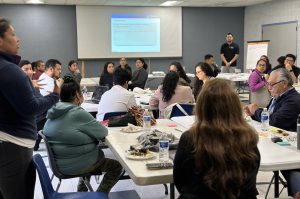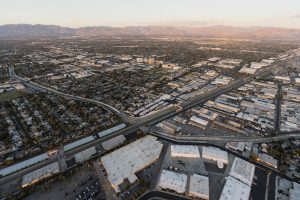
Advancing a Collaborative Agenda in Southeast LA
Advancing a Collaborative Agenda in Southeast LA In 2022, the California Community Foundation (CCF) launched the Regional Recovery Hub to strengthen place-based coordination in Los Angeles County
Variable Definitions:
Solid Waste Facilities Percentile: The percentile of a given area’s exposure to landfills, transfer stations, and composting facilities compared to the rest of LA County
For more information on the California Office of Environmental Health Hazard Assessment’s methodology, visit the CalEnviroScreen homepage.
Source:
California Office of Environmental Health Hazard Assessment – CalEnviroScreen 2.0 (2014), CalEnviroScreen 3.0 (2017), CalEnviroScreen 4.0 (2021)
Years Available:
CalEnviroScreen 2.0:
Data collected from 2009-2011 and published in 2014
CalEnviroScreen 3.0:
Data collected from 2012-2014 and published in 2017
CalEnviroScreen 4.0:
Data collected from 2017-2019 and published in 2021
“Many newer solid waste landfills are designed to prevent the contamination of air, water, and soil with hazardous materials. However, older sites that are out of compliance with current standards or illegal solid waste sites may degrade environmental conditions in the surrounding area and may expose nearby residents. Other types of facilities, such as composting, treatment and recycling facilities, may raise concerns about odors, vermin, and increased truck traffic. While data that describe environmental effects from the siting and operation of all types of solid waste facilities are not currently available, the California Department of Resources Recycling and Recovery (CalRecycle) maintains data on facilities that operate within the state, as well as sites that are abandoned, no longer in operation, or illegal.
Waste gases like methane and carbon dioxide can be released into the air from disposal sites for decades, even after site closure (Lou and Nair, 2009; Ofungwu and Eget, 2006; Weitz et al., 2002). Fires, although rare, can pose a health risk from exposure to smoke and ash (CalRecycle, 2010a; USFA, 2002). Odors and the known presence of solid waste may impair a community’s perceived desirability and affect the health and quality of life of nearby residents (Heaney et al., 2011). Although all active solid waste sites are regulated, CalRecycle has recorded a number of old closed disposal sites and landfills that are monitored less frequently. Former abandoned disposal sites present potential for human or animal exposure to uncovered waste or burn ash. In addition, an epidemiologic study of human births near landfills in Wales found an increase in the rate of birth defects after the opening or expansion of sites (Palmer et al., 2005).”
Excerpt from CalEnviroScreen 4.0
Citation:

Advancing a Collaborative Agenda in Southeast LA In 2022, the California Community Foundation (CCF) launched the Regional Recovery Hub to strengthen place-based coordination in Los Angeles County

In 2022, the California Community Foundation (CCF) launched the Regional Recovery Hub to strengthen place-based coordination in Los Angeles County regions that were most heavily impacted by
